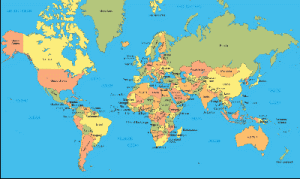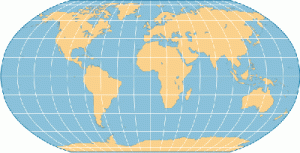Cartography, Pragmatism and the Liberation of Metaphysics
All maps are lies. That’s one of the first lessons of cartography, particularly when it comes to the problematic task of representing our 3-D world on a 2-D plane. It just can’t be done. At least, not without some distortion. Yet, even in the face of this necessary distortion, and in the absence of the ‘perfect’ map projection, cartography lives on. Why? Because maps are useful.
I think this is a notion that could lead to a ‘liberation’ of metaphysics, and its daughter disciplines of epistemology and ontology.
To explain why, we need to venture briefly into the world of map projections. Our planet is a globe. Or an oblate spheroid, if you want to be more precise. A world map is typically a 2-D plane. There is, as a matter of fact, no way to represent an oblate spheroid on a 2-D plane in such a way that it doesn’t distort some feature of the original globe.
This is where map projections come in. The one you may be most familiar with is the Mercator projection. It was developed by Flemish cartographer, Gerardus Mercator, in the mid-16th century, and (obscenely) is still used in schools and travel agencies – not to mention popular representations of the world – to this day.
This is despite the fact that the Mercator projection made a monumental sacrifice – i.e. correctly representing the true relative sizes of continents – in order to preserve ‘constant bearing’. This means that you can draw a straight line between any two points on a Mercator map and derive a bearing that will allow you to easily navigate to that destination – a useful feature for ships exploring the world during the Age of Discovery – but the picture of the world that it offers is grossly distorted as a result.
This is further hampered by the tendency to ‘trim’ Antarctica from the bottom, nudging the equator two-thirds of the way down the map (it runs just under the western ‘bump’ in Africa). The result is that Greenland looks absurdly huge, while ‘diminutive’ Australia is tucked into the bottom corner. In reality, Australia has an area three and a half times that of Greenland, and Sydney, for example, is actually at a similar latitude to Morocco rather than Reykjavík, as it appears.
This makes it great for navigating, but dreadful as a tool for giving us an appreciation for the size and shape of continents. (As such, I strongly recommend that you dispose of all Mercators in your possession – unless used for historical reference – and protest at its use as the default representation of the world. I do in public, frequently, much to my friends’ distress. But some things are more important than dignified behaviour.)
Thankfully, cartographers are well aware of the shortcomings of the Mercator as a general representation of the globe, and there is a flourishing industry in producing new projections of the world that are less obtuse. There are hundreds of alternative projections, from the Peter’s projection (equal area, but distorts shape and bearing), Goode homolosine (equal area, but interrupted), to the Robinson projection (an appealing compromise developed by National Geographic in the 1960s), to the spectacularly named Winkel Tripel (another compromise projection currently endorsed by National Geographic) and many, many more.
You can play around with them, or roll your own, with a brilliant piece of freeware called Flex Projector. My favourite (this week) is a synthesis of the rectangular Equidistant Cylindrical (Plate Carrée) and Sinusoidal (Sanson-Flamsteed). While fiddling with the various knobs and sliders, you’ll soon notice that no matter how hard you try, it’s just not possible to create a projection that doesn’t harbour some compromise somewhere. That’s to be expected.
In fact, one the the main jobs of cartographers is to pick the most suitable projection for your purpose. Need to sail from point A to point B (without GPS)? Perhaps a constant bearing map, like a Mercator, is the most appropriate. Want to see the correct relative sizes of continents? An equal-area projection is what you need. Maybe you need something that simply shows all continents in a reasonably realistic and aesthetically pleasing way. Go for a projection with gently curving meridians, like the Robinson. And so on. But remember, there is no ‘perfect’ map projection of our world.
Now, on to metaphysics.
The world-as-it-is – the ‘objective’, ‘noumenal’, ‘concrete’ world, whatever you want to call it – is our 3-D globe. The world-as-it-appears – the ‘subjective’, ‘phenomenal’, ‘abstract’ world etc – is the map projection.
As such, the pursuit of a ‘perfect’ systematised, abstract, propositional representation of the world is folly. But that doesn’t mean we should abandon all hope of understanding, or representing, the world-as-it-is.
Making the concrete world intelligible inevitably requires us to enforce distinctions, to carve things up into x and not-x, to abstract away particulars, leaving us with generalisations. Doing so inevitably results in us shedding some of the unique detail that is fundamental to the concrete world. It flattens the spheroid.
Yet metaphysics and epistemology still strive to find the abstraction that best represents the world – or that is the ‘perfect’ representation of the world. The failure of metaphysics and epistemology to achieve this goal lends evidence to the notion that, like making the ‘perfect’ map projection, it just can’t be done.
However, this doesn’t necessarily lead us to a skeptical conclusion. This is because there’s a difference between ‘distortion’ and ‘error’. An erroneous map projection would seek to represent some aspect of the world in some way, and fail to do so. Placing Australia in the northern hemisphere, for example, would be an error. But ‘distorting’ Australia’s shape in order to preserve constant bearing is different. Providing supernatural explanations of natural phenomena is an error. Employing the empirical method to infer laws of nature that can be used to predict future phenomena is a distortion.
While we may never have an intelligible metaphysics without distortion, that doesn’t mean all metaphysical systems will be in error.
And we choose which distortion we’ll live with depending on the purpose we have on hand, like in cartography; the Mercator is good for navigating, bad for representing the relative size of continents.
I take this to be my (roundabout) definition of metaphysical pragmatism. It’s an approach that is non-skeptical, but acknowledges our inability to perfectly represent the world in an abstract system. Yet it also acknowledges the use of skilfully applied distortions – such as by carving the world into forms, or x and not-x – in order to achieve some practical end.
Moreover, it rejects the claim that the world-as-it-is, the ‘objective’ world, is somehow fundamentally separated from the world-as-it-appears, the ‘subjective’ world. Instead it sees the subjective as being a part of the objective. We are in-and-of, the world, not external observers to it. The subjective is just one projection, but it’s a projection of the objective world.
That is what I call the pragmatic liberation of metaphysics through cartography.



2 Comments
Mark Sloan · 15th June 2010 at 6:12 am
I had no idea the Mercator projection we useful (in pre GPS navigation) because such maps correctly represented the ‘bearing’ between points. Cool.
To your overall point, “the pursuit of a ‘perfect’ systematised, abstract, propositional representation of the world is folly”. I agree that it is folly to abandon pursuit of potentially useful representations just because they are imperfect from the standpoint of ‘distortions’.
Two comments though:
With the same view, it is also, a priori, impossible to say that people are incapable of making such a representation of the world. It just seems unlikely based on experience to date.
Second, in addition to the layer of any distortion created by world-as-it-appears compared to the world-as-it-is there is, what is to me, a distinct layer of distortion created by language due to its limited ability to represent world-as-it-appears. I don’t know if specialists in language would agree or not.
In any event, I applaud your definition of metaphysical pragmatism. Any engineer will tell you the old saying is true that “The pursuit of the perfect is almost always the enemy of the pursuit of the good”.
simbel · 22nd June 2011 at 11:00 am
I thoroughly enjoyed this article.